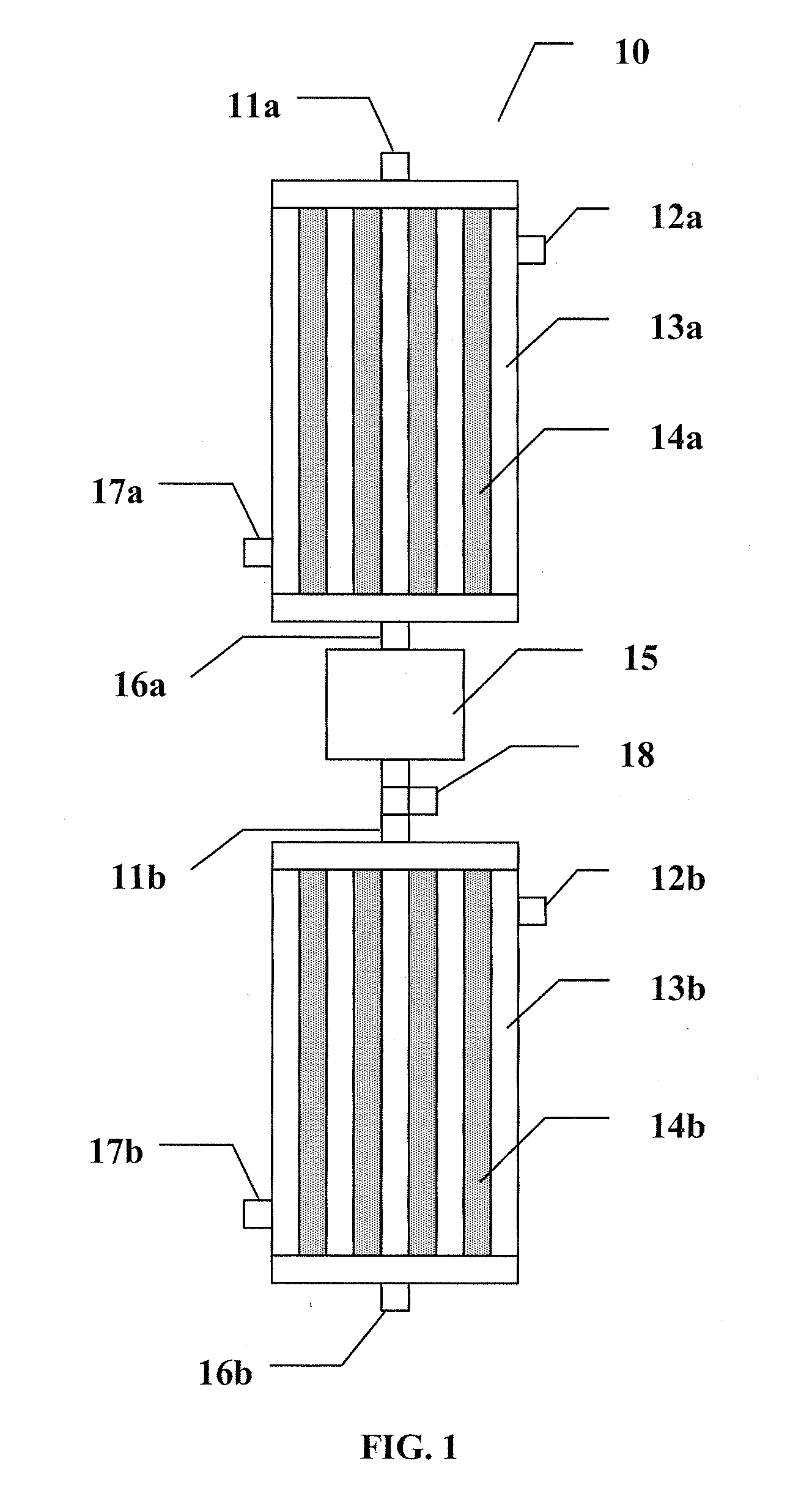Production of dry alcohol
a technology of dry alcohol and distillation process, which is applied in the direction of oxygen compound purification/separation, light and heating apparatus, chemical production, etc., can solve the problems of large amount of energy, large amount of distillation process, and considerable additional energy, and achieve the effect of increasing the energy efficiency of the process
- Summary
- Abstract
- Description
- Claims
- Application Information
AI Technical Summary
Benefits of technology
Problems solved by technology
Method used
Image
Examples
example 1
Inventive-Simulation
[0108]Water-gas shift in the adiabatic multistage reactor with cooling between stages—10 wt % of water in the feed.
[0109]The reactor is 2 meters long and consists of 4000 tubes, each 1″ in diameter. The reactor operates at 3.4 atm of pressure. The reactor has three quenching points at 10, 25 and 50% of reactor length, and thus, the reactor is divided into four stages. The first stage is 0.2 meters long, the second stage is 0.3 meters long, the third stage is 0.5 meters long, and the final stage is 1 meter long.
[0110]A feed of 20, 510 kg / hr (45,000 lb / hr) of a mixture of ethanol and water containing 10 wt % of water is injected at a temperature of 250° C. into the four-stage adiabatic reactor with cooling between stages. The amounts of catalyst at the four stages are, in order, 405, 608, 1013 and 2026 liters. The molar excess of CO relative to H2O is 2 and the velocity in the bed is 1.3 m / sec. The exit temperature after each stage is lowered to 250° C. by use of a...
example 2
Inventive-Simulation
[0113]Water-gas shift in the adiabatic multistage reactor with cooling between stages—20 wt % of water in the feed.
[0114]The conditions are the same as in Example 1, except that the inlet gas contains 20 wt % of water. The velocity in the bed is 1.8 m / sec. The conversions at the four stages are 0.275, 0.604, 0.909 and 0.978, and the exit temperatures are 299.2, 308.5, 303.8 and 262.3° C., respectively. Water conversion and Temperature profiles are shown on FIG. 3a and FIG. 3b, respectively.
[0115]The composition of the final exit gas is 0.48% water, 22.39% CO, 21.43% CO2, 21.43% H2 and 34.27% ethanol (molar fractions). After condensation of ethanol and water and absorption of CO2 in ethanolamine, the gas contains 51.09% CO and 48.91% H2. In the process, 97.8% of the water is removed, and the purity of the ethanol after condensation is 99.5 wt %.
example 3
Inventive-Simulation
[0116]Water-gas shift reaction in a cooled first stage tubular reactor (thus non-adiabatic) is followed by an adiabatic 2 stage reactor with cooling between stages.
[0117]A reactor inlet stream is produced by mixing pure CO from a carbon combustor with overhead vapor from a beer column containing 66 wt % water and 20% of recycle stream. Recycle stream refers to a gas stream that was used in a previous process cycle and in which any ethanol and water were removed by condensation, and CO2 was removed by an absorptive means. The recycle stream includes CO as well as H2 that was produced in a previous cycle.
[0118]The mixture, which contains 33.33% water, 16.66% ethanol, 33.33% CO, 8.33% CO2 and 8.33% H2 is injected at a rate of 4,574 kmol / hr into a first stage tubular non-isothermal non-adiabatic reactor with 6,000 tubular reaction spaces (tubes), 2.54 cm (1 inch) internal diameter, each 6 m long, operating at 227° C. (inlet) and 5 atmospheres pressure. The stream en...
PUM
| Property | Measurement | Unit |
|---|---|---|
| Temperature | aaaaa | aaaaa |
| Temperature | aaaaa | aaaaa |
| Temperature | aaaaa | aaaaa |
Abstract
Description
Claims
Application Information
 Login to View More
Login to View More - R&D
- Intellectual Property
- Life Sciences
- Materials
- Tech Scout
- Unparalleled Data Quality
- Higher Quality Content
- 60% Fewer Hallucinations
Browse by: Latest US Patents, China's latest patents, Technical Efficacy Thesaurus, Application Domain, Technology Topic, Popular Technical Reports.
© 2025 PatSnap. All rights reserved.Legal|Privacy policy|Modern Slavery Act Transparency Statement|Sitemap|About US| Contact US: help@patsnap.com



